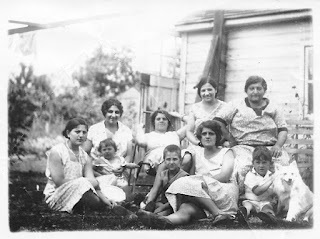 |
| You can have your own genealogy research library! |
I've been building my fortified family tree for 15 years. I started by writing down facts in a black and white composition notebook. I graduated to Family Tree Maker software so I could see the bigger picture. I developed a meticulous digital filing system.
After all these years, you know what I discovered? I have my own genealogy research library!
And you can, too.
What's In My Library
If you've been enjoying this genealogy hobby for any length of time, I'll bet you've gotten better at it. You've learned. You've figured out how to do things. You've gathered a lot of facts and materials.
My largest, most valuable collection of genealogy data contains Italian birth, marriage and death records from my ancestral hometowns. I have about 40 gigabytes of these vital records on my computer. They're there for me anytime I want to trace a family back to Italy. (See
Collect the Whole Set!)
I realized I have a genealogy research library while looking at a family photo from the summer of 1930. After 10 years, I still didn't know the exact identity of a woman in the photo and her relationship to me.
Here's what I did know. The woman, who was several years older than my grandmother (also in the photo), was named Pastore and was somehow related to my Sarracino family. That's my grandmother's maiden name.
Then it hit me. I have all those vital records from the Italian hometown of my Sarracino ancestors. Why don't I look through them for anyone named Pastore and see what I can find?
Putting My Library to Use
My collection for their town (Sant'Angelo a Cupolo) begins in 1861. My grandmother was born in 1899. Based on how she looks compared to Grandma, the Pastore woman in the photograph was born in the 1880s.
I'm transcribing facts from thousands of Italian vital records into a massive spreadsheet...in my spare time. That will make searches much easier. It's going to take a lot of time, but what an amazing resource it will be!
That project is far from finished. So I looked through the Sant'Angelo a Cupolo birth indexes, and I found a Pastore. Not the woman in the photograph, but a boy named Nicolantonio Pastore with a mother named…can you guess?…Maria Giuseppa Sarracino.
Aha! A Pastore-Sarracino connection. "Let's keep searching," I thought. I found six Pastore babies born to Carmine Pastore and Maria Giuseppa Sarracino between 1877 and 1889.
The last one I found is the prize. The moment I saw her 1889 birth record, Maria Carmela Pastore became my number one prospect to grow up to be the woman in the photo.
I needed more information, so I turned to another wing of my genealogy research library.
In my "shoebox" on Ancestry.com, I'd saved a ship manifest. It was a 1902 passage from Naples to New York of a mother and daughter. The mother was Maria Giuseppa Sarracino, and her daughter was 12-year-old Maria Carmela Pastore. They were going to join Carmine Pastore in the Bronx—in my family's neighborhood. All the ages and names matched.
Yesterday I added all these Pastore names, dates and documents to my Family Tree Maker file. At this moment, they are not connected to me in any way. But they will be; I have faith.
Here's my working theory. Maria Giuseppa Sarracino's father was Antonio. He may be my 3rd great grandfather, also named Antonio Sarracino.
I'll keep consulting my library and doing online searches to try to find the exact connection. I hope to prove or disprove my working theory.
What's In Your Library?
If your roots are anywhere else, sign up for a free account with FamilySearch.org. See if they offer any collections from the towns that matter to you. Browse them online, or download a collection of images to your computer with a program called GetLinks. (For complete instructions, see the link above and scroll to the bottom of the article. The software is in Portuguese, so the instructions are important.)
As part of my 2018 to-do list (see
What Are Your Genealogy Goals for 2018?), I wanted to create a thorough backup plan for my genealogy files. I've made my plan. I backed up my massive Italian vital record collection in two places (besides my hard drive): an external drive and Microsoft's OneDrive. Each of these offers me one terabyte of storage. The external drive cost $75 and the OneDrive space comes with my Office 365 subscription.
Try using bookmarks or the "shoebox" (if you use Ancestry.com) to hold onto items you think will help you later. It thrilled me to find the Sarracino-Pastore immigration record and a Pastore census form in my shoebox. Now they're in my Family Tree Maker file.
Every document or collection you can download or stick a pin in online, and every paper document you've gathered are the contents of your genealogy research library. Don't overlook the possibility that the answers you need are already in your hands.










